

LIBERTY! . Teacher's Guide. Revolutionary War Music. Lesson 5: REVOLUTIONARY WAR MUSIC Investigate some of the more familiar and famous songs of the Revolutionary War period and how music was used to convey messages of patriotism and highlight popular sentiments.
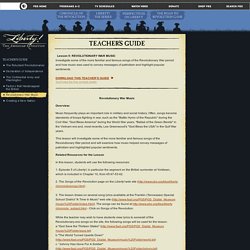
You’ll need the free acrobat reader. Overview: Music frequently plays an important role in military and social history. Digital History (Revolutionary War Music Lesson Ideas) Music and the American Revolution John Adams thought that a third of the colonists supported the Revolution, a third remained loyal to Britain, and a third was undecided or neutral.

The popular songs of the Revolutionary reflect a deep divided within the colonial population. Loyalists were those Americans who affirmed Britain's authority over the colonies. Although revolutionaries vilified them as elitists who personally benefited from British colonial rule, many were genuinely commitment to maintaining a colonial bond with the mother country. American Revolutionary War Flags. British East India Company Flags c1678-1800 Of course, if you really want to know who caused the American Revolution, the answer is the British East India Company, originally, called the English East India Company, but renamed in 1707.
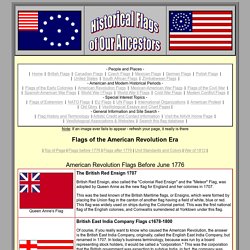
In today's business terminology, because was run by a board representing stock holders, it would be called a "corporation. " This was the corporation that the British government was expecting to subdue India, in fact, the company was expected to pay for the soldiers to do so. However, the company ran into so many problems in India that the British parliament had to bail them out by passing laws that required the American colonists to buy the company's tea. Although ships flying this company flag never directly entered American waters, ships transporting their tea, and flying the British Red Ensign, did. Music of Washington's Time. AmericanRevolution.org THE MUSIC OF GEORGE WASHINGTON'S TIMEby John Tasker Howard expanded and updated for the web.
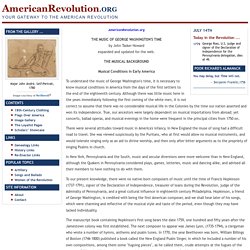
Musical Conditions in Early America. Revolutionary War Musical Instruments. Fife, Drum, and Bugle During the Revolutionary War During the Revolutionary War, armies didn’t have radios to talk to each other with.
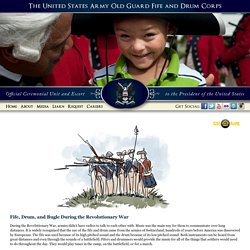
Music was the main way for them to communicate over long distances. It is widely recognized that the use of the fife and drum came from the armies of Switzerland, hundreds of years before America was discovered by Europeans. The fife was used because of its high pitched sound and the drum because of its low pitched sound. Both instruments can be heard from great distances and even through the sounds of a battlefield. Revolutionary War Music - Archiving Early America.
Music of the Revolution. Yankee Doodle Yankee Doodle, Oil on Canvas by A.M.

Willard Every American school child learns the tune of Yankee Doodle before they leave elementary school, but few people know the origins of the song. Some of the words are: Yankee Doodle went to town Riding on a Pony Stuck a feather in his hat And called it macaroni A British Army surgeon named Richard Shuckburg first penned the verses during the French and Indian War to make fun of colonial soldiers. "Yankee" was a derogatory term attached to New Englanders - and in those days, macaroni wasn't a noodle, but a foppish or effeminate hair style. The United States Army Old Guard Fife and Drum Corps - Recordings. American Revolutionary War Song:Ballad of the Green Mountain Boys. Lesson Plans - The Star Spangled Banner. Lesson Plans - War of 1812 (By Grade) The War of 1812. Although its events inspired one of the nation’s most famous patriotic songs, the War of 1812 is a relatively little-known war in American history.
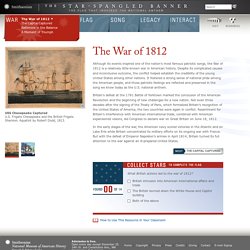
Despite its complicated causes and inconclusive outcome, the conflict helped establish the credibility of the young United States among other nations. It fostered a strong sense of national pride among the American people, and those patriotic feelings are reflected and preserved in the song we know today as the U.S. national anthem. Britain’s defeat at the 1781 Battle of Yorktown marked the conclusion of the American Revolution and the beginning of new challenges for a new nation. Not even three decades after the signing of the Treaty of Paris, which formalized Britain’s recognition of the United States of America, the two countries were again in conflict.
Resentment for Britain’s interference with American international trade, combined with American expansionist visions, led Congress to declare war on Great Britain on June 18, 1812. Star-Spangled Banner and the War of 1812. The original Star-Spangled Banner, the flag that inspired Francis Scott Key to write the song that would become our national anthem, is among the most treasured artifacts in the collections of the Smithsonian’s National Museum of American History in Washington, D.C.
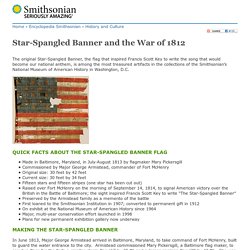
Quick Facts about the Star-Spangled Banner Flag Making the Star-Spangled Banner In June 1813, Major George Armistead arrived in Baltimore, Maryland, to take command of Fort McHenry, built to guard the water entrance to the city. Armistead commissioned Mary Pickersgill, a Baltimore flag maker, to sew two flags for the fort: a smaller storm flag (17 by 25 ft) and a larger garrison flag (30 by 42 ft). She was hired under a government contract and was assisted by her daughter, two nieces, and an indentured African-American girl. History of the Star Spangled Banner. Francis Scott Key - Biography - Poet, Lawyer - Biography.com.
Francis Scott Key was an attorney and poet who wrote the lyrics to "The Star-Spangled Banner," the U.S. national anthem.
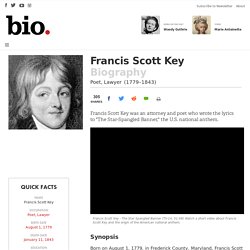
Synopsis Born on August 1, 1779, in Frederick County, Maryland, Francis Scott Key became a lawyer who witnessed the British attack on Fort McHenry during the War of 1812. The fort withstood the day-long assault, inspiring Key to write a poem that would become the future U.S. national anthem, "The Star-Spangled Banner. " Key later served as a district attorney for Washington, D.C. He died on January 11, 1843. Early Life and Career. The U.S. National Anthem - The Star Spangled Banner. "The Star Spangled Banner", was ordered played at military and naval occasions by President Woodrow Wilson in 1916, but was not designated the national anthem by an Act of Congress until 1931.

War of 1812 - Our Flag Was Still There. Civil War Music Lesson Plan. Civil War Music: When Johnny Comes Marching Home - Lesson Plan w/Primary Sources. Skip navigation Library of Congress Teachers Suggestions enabled. The Library of Congress > Teachers > Classroom Materials > Primary Source Sets > Civil War Music Print Subscribe Share/Save Give Feedback. American Civil War Flags. 20th Maine Regimental Flag The 20th Maine was organized in the state of Maine in 1862.
It became part of the 1st Division of the V Corps of the Army of the Potomac. Band Music from the Civil War Era. On September 27, 1974, the Music Division of the Library of Congress re-created a typical concert of brass band and vocal music from mid-nineteenth-century America. That concert has become the starting-point for Band Music from the Civil War Era, an online collection that brings together musical scores, recordings, photographs, and essays documenting an important but insufficiently explored part of the American musical past.
The cornets and saxhorns that made up the all-brass bands of the 1850s remained a popular, though decreasingly prominent, feature of American wind bands through the nineteenth century. Bands of this kind served in the armies of both the North and the South during the Civil War, in the field as well as for the entertainment of the officers. Most of the sheet music used by these brass bands, which typically existed only in "part books" for individual instruments, has long been lost. A. Brass Band Journal. Band Music from the Civil War Era. Civil War Music Instruments. Songs of the American Civil War. By Ramona Garcia, Fairfield, Ct., USA The songs of the Civil War contain distinct echoes of that era. These songs expressed or came to express a multitude of emotions associated with this great conflict: patriotism, martial pride, death, homesickness, loneliness, love, and hope.
As reflections of this conflict these songs provide a more human approach to and understanding of the Civil War era. Charles Hamm in Yesterdays: Popular Song in America acknowledges that: Music During the American Civil War. John Brown's Body - The Battle Hymn of the Republic - Songs and Poems- Lyrical Legacy. Great songs sometimes seem to have a life of their own and survive by adapting to changing times and sensibilities. The song we now know as "The Battle Hymn of the Republic" has endured for more than 150 years and during that time underwent several dramatic changes in personality, as different writers and singers adapted it to meet their needs. The original version was a religious camp meeting song written in the 1850s and began "Say, brothers, will you meet us? On Canaan’s happy shore? " The song eventually spread to army posts, where its steady rhythm and catchy chorus made it a natural marching song.
Soon, though, a new version appeared that hitched the old tune to a more militant cause.